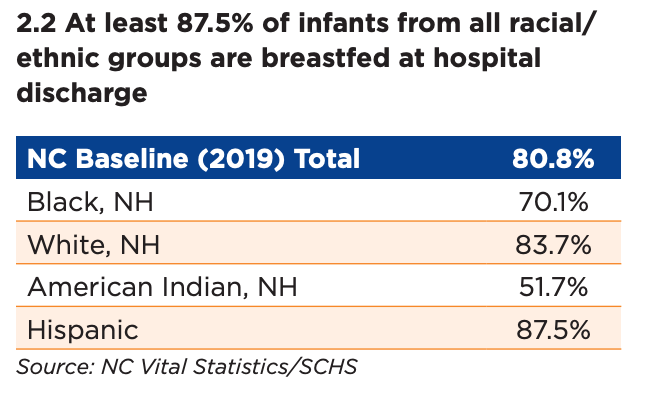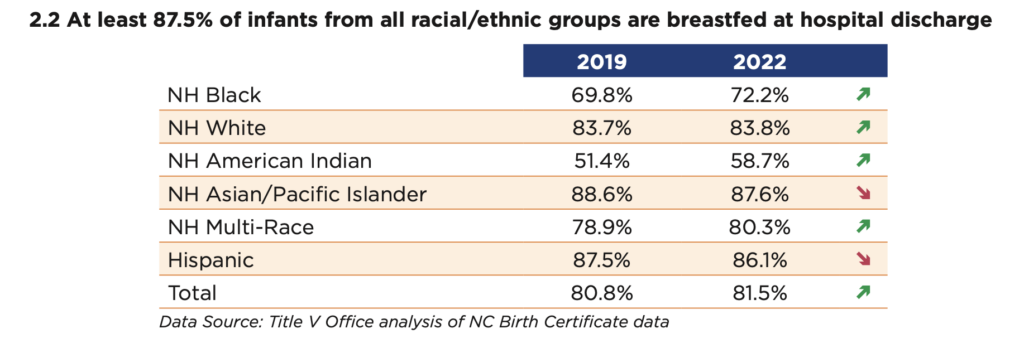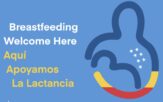Breastfeeding is a critical aspect of perinatal health, and the NC Perinatal Health Strategic Plan (PHSP) for 2022-2026 recognizes this by including strategies to promote and support breastfeeding. Breastfeeding is a key factor in improving infant health outcomes and reducing the risk of maternal and infant mortality.
In the Perinatal Health Strategic Plan, breastfeeding/chestfeeding is explicitly mentioned and recognized under Goal 1 – Address Economic and Social Inequities, Point 2 – Support Working Parents and Families:
- Goal 1, Point 2C Strengthen policies to support breastfeeding in the workplace and in childcare centers, and increase knowledge and uptake of breastfeeding friendly policies
- Goal 1, Point 2D Increase enrollment in Pathway 2 and Pathway 3 lactation training programs, and increase reimbursement for the breastfeeding support workforce
- Goal 1, Point 2G Eliminate taxation on sanitary products including menstrual supplies, diapers, and breastfeeding supplies

The PHSP recognizes that breastfeeding rates are lower among Black and Indigenous mothers and seeks to address this disparity through its focus on health equity. The PHSP includes several strategies to promote and support breastfeeding, including increasing access to lactation support services, promoting policies that support breastfeeding in the workplace, and providing education to healthcare providers and families about the benefits of breastfeeding. The PHSP also recognizes the importance of addressing the root causes of disparities in breastfeeding rates, such as structural racism and economic and social inequities. By focusing on the drivers of health, including economic and social inequities, strengthening families and communities, and improving health care for all people of reproductive age, the PHSP seeks to create a more equitable and just healthcare system. The PHSP recognizes that achieving health equity requires collaboration and partnerships among public, nonprofit, and private organizations, and the plan seeks to engage a diverse range of stakeholders to ensure that all voices are heard and that the plan is responsive to the needs of all communities. In conclusion, the NC Perinatal Health Strategic Plan for 2022-2026 is a comprehensive and ambitious plan to improve maternal and infant health outcomes and promote health equity in North Carolina. By recognizing the importance of breastfeeding and addressing the root causes of disparities in breastfeeding rates, the plan seeks to create a more just and equitable healthcare system that promotes the health and well-being of all North Carolinians.

Breastfeeding Rates at Hospital Discharge: 2019 vs. 2022
The data on breastfeeding initiation at hospital discharge from 2019 to 2022 demonstrates both progress and ongoing challenges across various racial and ethnic groups. In 2022, at least 87.5% of infants from all racial/ethnic groups were breastfed at hospital discharge, reflecting positive trends driven by initiatives like Breastfeed Durham and the NC Perinatal Health Strategic Plan.
- Non-Hispanic Black infants saw a modest increase from 69.8% in 2019 to 72.2% in 2022.
- Non-Hispanic White rates remained steady, with a slight increase from 83.7% to 83.8%.
- Non-Hispanic American Indian mothers showed significant progress, with breastfeeding rates rising from 51.4% in 2019 to 58.7% in 2022.
- Non-Hispanic Asian/Pacific Islander rates slightly declined from 88.6% to 87.6%.
- Non-Hispanic Multi-Race mothers experienced an increase from 78.9% to 80.3%.
- Hispanic rates saw a small decrease from 87.5% to 86.1%.
Overall, the total breastfeeding rate at hospital discharge improved slightly from 80.8% in 2019 to 81.5% in 2022, showcasing steady progress in supporting breastfeeding across diverse communities. However, disparities among certain racial/ethnic groups, such as Non-Hispanic Black and American Indian mothers, remain a concern and emphasize the need for continued efforts toward health equity.
View the NC Perinatal Health Strategic Plan for 2022-2026 below:

